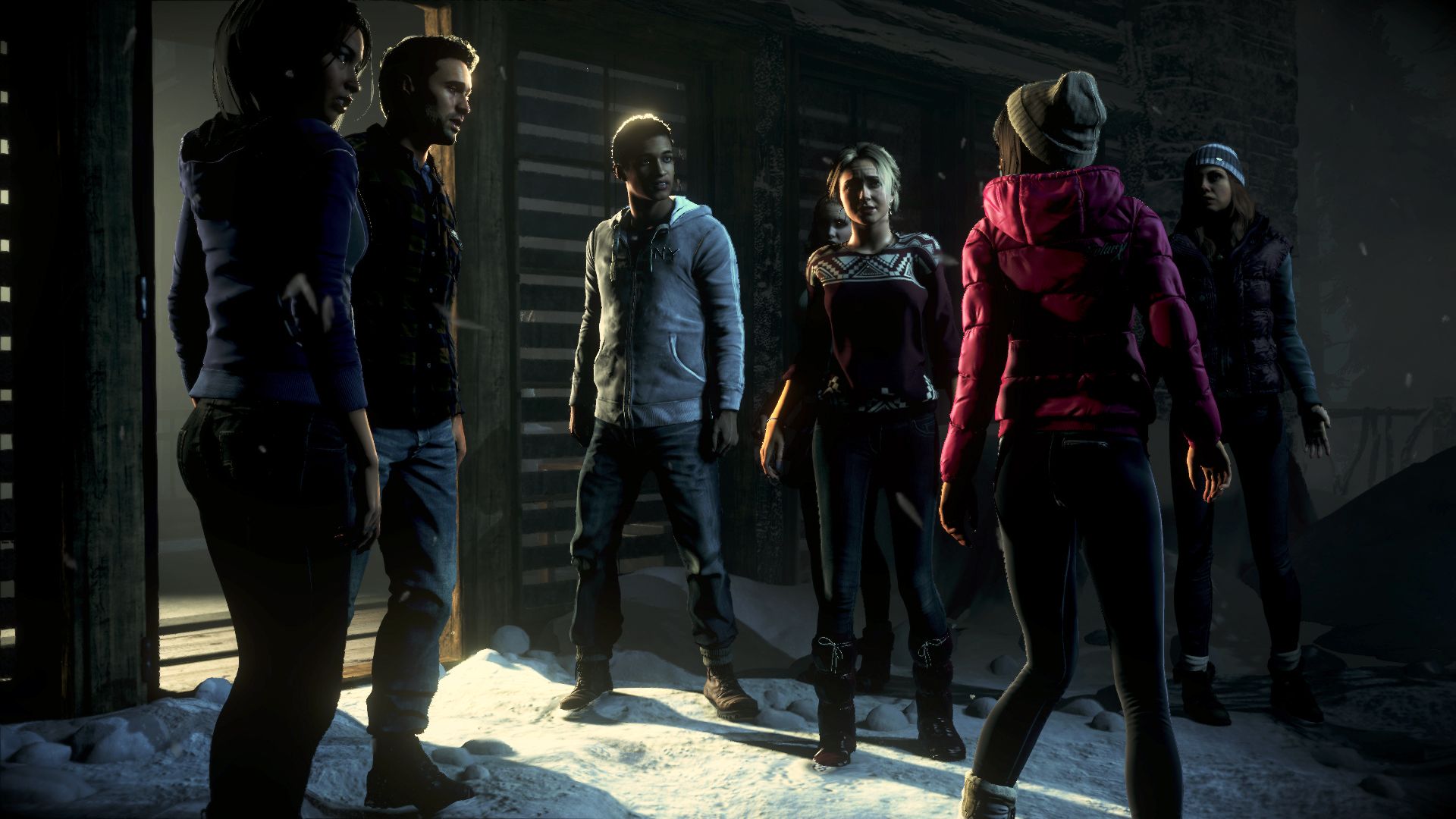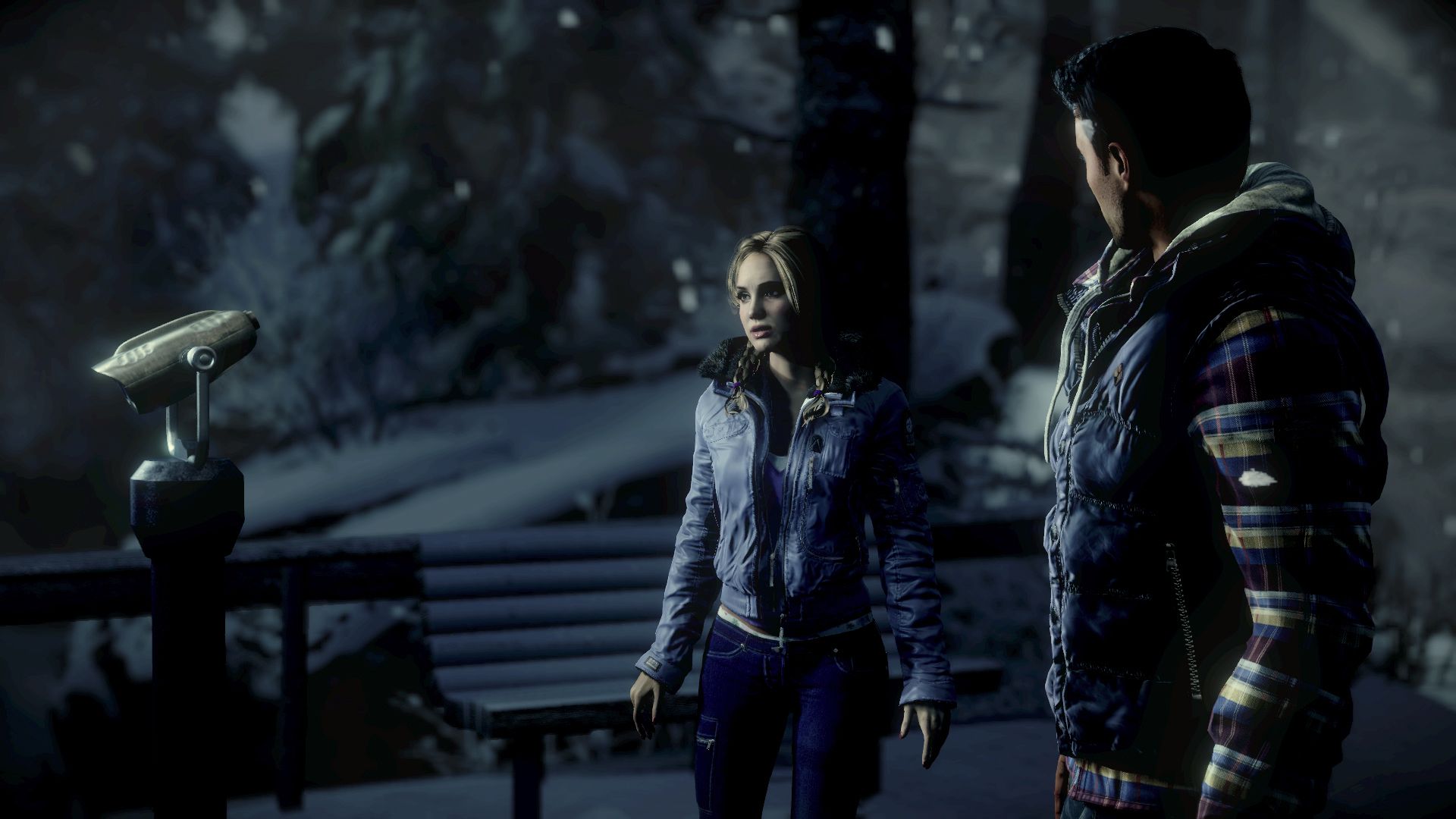Until Dawn Review
Well-paced horror that takes risks and keeps you invested
Until Dawn, by all rights, shouldn’t be very good. First announced in 2012 as Supermassive’s third game built specifically for the PlayStation Move, the game spiraled off the radar before re-emerging in 2014, looking like the PlayStation 4 exclusive we know today. But it’s not just the development history that works against Until Dawn, the very conceit of eight spoiled teenage brats being stuck on a mountain and murdered one by one sounds so ridden with genre love-letter cliches it seems bound to be dismissible. The Quantic Dream-style of choose your own adventure gameplay seems shoe-horned in to avoid tying the game’s outcome to the ill-fate Move hardware. The inclusion of Hayden Panettiere and Peter Stormare sounded like the oft-heard desperate plea of a dying video-game trying to scrounge up interest with semi-famous actors. Until Dawn should be awful, but it’s not. In fact, it’s quite good.

Until Dawn doesn’t make a very good first impression. For the first hour, my fears for the game seemed realized. It starts with a long tutorial which acts as a prologue for the game’s narrative. All of the off-putting quirks in the gameplay are immediately on display. When you select an item to interact with, it can take a second or two before you actually pick it up and look at it. The third-person controls used when exploring areas are kind of like tank controls with one analog stick controlling where you look and another controlling where you walk resulting in a couple times where the character would walk into a tree or fencepost. At times the motion capture animations hit the lows of the uncanny valley as characters make weird gestures or odd expressions. The voice acting for the character you play in the tutorial is pretty bad. The giant choice at the end of the tutorial has no effect on the game and the climax isn’t very scary. The opening moments of Until Dawn are kind of a trainwreck.
Luckily, the game quickly goes into recovery mode. After the prologue, the first couple hours of Until Dawn focus on establishing the relationships between the characters. There’s eight unlucky teens in the game and fleshing out that many characters would be tough if Supermassive didn’t lean on some character archetypes provided by the horror genre. There’s our heroine, the girl you know will make it to the end. Our charming, ne’er-do-well leading man who only gets more attractive when he is dirty, beat up and fighting for their lives. There’s the snobby mean girl, the star-crossed lovers, the grieving family member, the meathead jock, and the floozy blonde—they’re all here.
The plot of Until Dawn is another spot where it subverts your expectations, becoming a more interesting story than you would initially think. The premise of eight teens trapped on a lonely mountain with a killer on the loose is tried and true horror fare, but Until Dawn digs deeper with its tale. The game taps all types of horror genres: the supernatural, the slasher, torture, gore, and monsters. However, as you progress into the story, you begin to realize some of the terrors in the game aren’t what they seem. There’s a good mystery to unravel and Until Dawn delivers some unexpected twists that are pretty smart. As far as horror stories go, Until Dawn’s is strong and any who wrote it off as another retelling of teens dying at the hands of a crazed maniac will be quite surprised.

Even with its bad start, Until Dawn manages to get you invested. The kids who start out so bland become people you root for and remember, with their own motivations and relationships. Their peril seems genuine and you want to help them escape. Each death has weight because you feel responsible due to your choices. It’s a level of attachment I’ve rarely known in the horror genre and it’s all set up by the fact you have a stake in who lives and dies. I thought I would enjoy killing off some characters, using them as sacrificial lambs to save the others, but by the end of both playthroughs I was compelled to save everyone–even though I couldn’t. It’s impressive how Supermassive connects you to the fate of these kids.
There isn’t a ton of ways Until Dawn can play out. After a couple of six hour playthroughs, I feel like I’ve seen most of what the game has to offer. The story largely can’t be affected by the choices presented. There are certain sequences that you can’t change, locations you have to visit, and characters who have to stay alive. Supermassive didn’t pay Hayden Panettiere Hollywood money to die in the first hour. You could intentionally tank your way through the game and still have a couple of kids alive for the final chapter. Also, once you’ve played the game a couple times it’s easy to see where you went wrong and how you can save all your characters, like maybe you shouldn’t have separated that character from the group to investigate that strange noise.
The magic of Until Dawn is in not knowing, it’s what most horror is predicated on. The first time playing through the game is a nerve wracking experience because you never know if a simple quicktime sequence will result in the death of a character or which choices could be fatal. Your actions are emotional, and the game plays on your fears. Supermassive does a great job of hiding important choices in seemingly benign moments. When paying the game a second time a lot of that magic is gone and you can start to pick up on the mistakes you made. This isn’t a bad thing, a six to eight hour game packed with tough choices and some good scares is nothing to scoff at. Just don’t expect an endless spider-web of storytelling.

When you’re not faced with choices or quicktime sequences, you’ll be exploring the eerie environments which make up the setting of Until Dawn. With abandoned mines, a decrepit sanitarium, a dark ski-lodge, and a large forest, there are plenty of great areas filled with an atmosphere of foreboding. While searching these areas you can find clues to unravel the mystery of the narrative, but more importantly you can find totems. Totems allow for you to catch a glimpse of an upcoming choice. Some totems will warn you of the consequences of a bad choice, some will show benefits of the right choice. For instance, seeing a glimpse of a character drowning is going to make you very nervous whenever you are near water because you will be anticipating the choice which could lead to a scenario seen in the totem. It’s a delightful mechanic which helps players feel like they’re not arbitrarily sending characters to their death.
Until Dawn is broken up into chapters and in between those chapters you interact with a therapist played by Peter Stormare. These sequences seem to have little to do with the plot, but are more for the flavor of the game. Talking with this therapist gets you thinking about your worst fears, the characters you’ve become the most attached to, and the plot which is unfolding. The very nature of who the therapist is, if he’s even a therapist, and who he is talking to is another little mystery which adds to the tension of the game.
While there are moments where Until Dawn falls victim to the uncanny valley, there are some really stunning technical moments. Each character is modeled after their voice actor and at times it’s pretty impressive to see just how far Sony’s motion capture technology has come. This is one of the few games where players may recognize an actor by their look instead of their voice. There were a couple of moments I noticed the game chug when processing a decision and I saw a couple of pop-in textures, but Until Dawn is a pretty sound game tech-wise.

Until Dawn may not be the best horror game since Amnesia: The Dark Descent, but it is certainly the most creative horror game since the genre began leaning on the first-person experience. The game is well paced, balancing some strong jump scares with quiet moments of dread and fun moments of levity. It nods to the horror genre, but isn’t afraid to take risks with its narrative that other horror stories would shy away from. It continually plays on your expectations, not only for scares, but to craft a more interesting game. The choices presented in the narrative aren’t game-changing, but you never know when the wrong decision is going to lead a character to their grave. This constant fear is what makes Until Dawn work so well. Until Dawn isn’t just a game that horror fans will enjoy, but something that is fun for anyone who likes narrative-heavy, choice-based gameplay. Grab a friend who isn't scared to hold your hand, turn down the lights, and see how many characters you can keep alive through the night.
 Comments
Comments



















